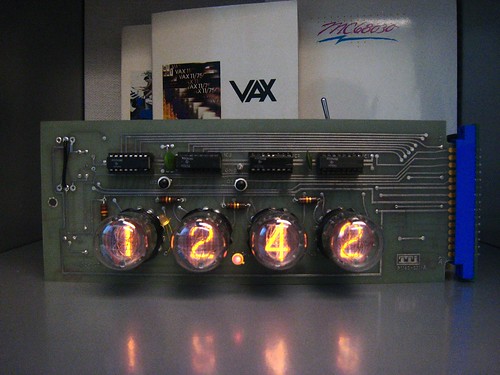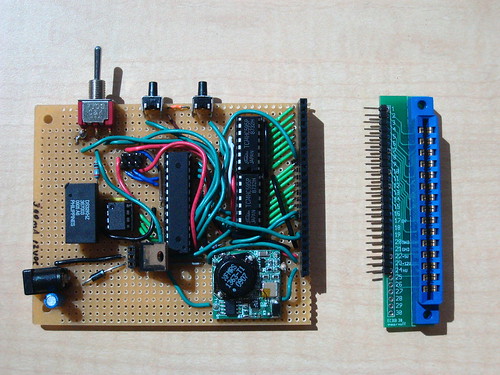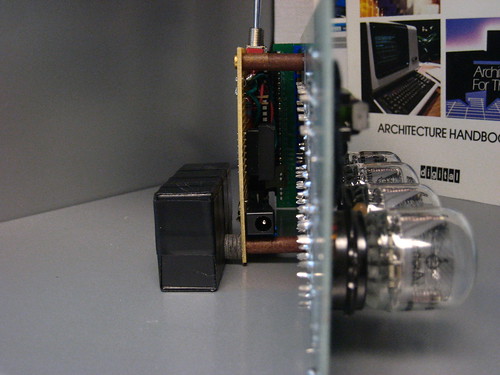Nixie Clock II
July 2009

My second Nixie clock, created from found hardware.
On a previous trip to the Silicon Valley Electronics Flea Market I found some curious boards in a box. They were date-stamped 1971, had B13B tube sockets, card edges, ancient LEDs, and 74141 chips.
Sure enough, they were Nixie display boards. After poking them with a continuity tester for a while, I figured out the pinout of the edge connector, and found a socket to match it. Since the socket pins had weird spacing, I had some adapter boards made, which brought all connections out to a row of 100-mil spaced pins.
The tubes are JAN 8421's, new old stock, bought on eBay.
Then, I built a clock circuit on a perfboard (almost the same design as my previous clock), using one of John Taylor's 1363 power supplies to generate the high voltage for the Nixie tubes. John's power supplies are great since they can run from an incredibly wide range of input voltages; as high as 16V, and as low as 1.5V! The only downside is that the two rows of pins are not an even multiple of 0.1" apart, so they need to be bent slightly to fit in a breadboard or perfboard.

The perfboard connects the the card adaptor and sits behind (and parallel to) the Nixie board. In addition to the pin header, two screws are used to attach the boards; two phenolic spacers were super-glued onto the back of the Nixie board. Since the whole thing has all its weight in the front, a steel block was added to the back to keep the clock from falling over.

Two buttons on the top allow you to set the time and date, and a toggle switch allows you to blank the display. When the switch is in the center position, the power to the high-voltage supply is cut off. When in the left position, the display is always on. When in the right position, the clock follows a programmed "schedule." Since it's currently in my office, the clock is programmed to turn the display on when I come into work at 9, turn off when I leave at 6, and stay off on weekends.
The month and day are displayed twice per minute, with a short "scramble" transition that not only looks cool, but prevents cathode poisoning by exercising digits that would normally be unused.
I think I like this one better than my first clock. While cabinets are nice, the exposed board is a great showcase of 40-year-old technology in all its glory. Plus, there's something exciting about having about un-insulated high-voltage traces out in the open. ;-)
Here's a video of the clock in action:
photos
Photo gallery is on Flickr.schematic
I didn't draw up a schematic, but the basic timekeeping circuit practically identical to the one I used in my first clock.
